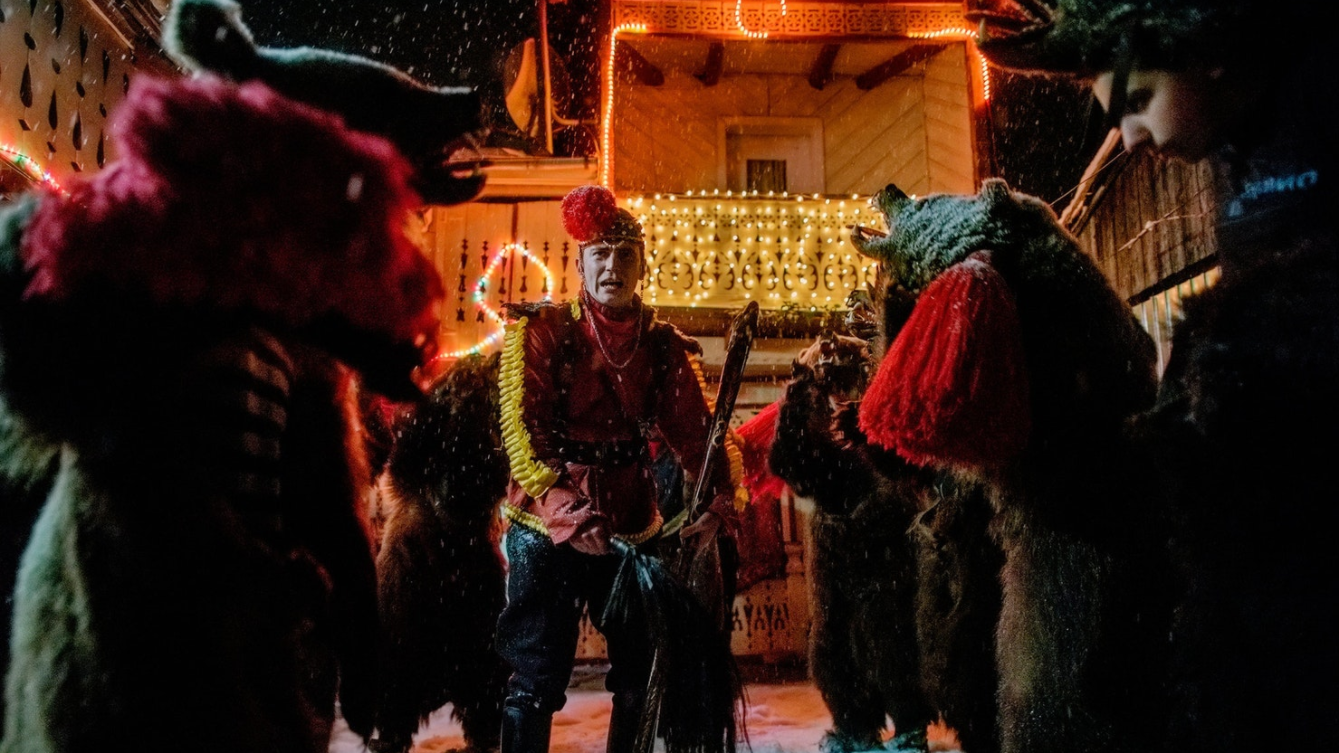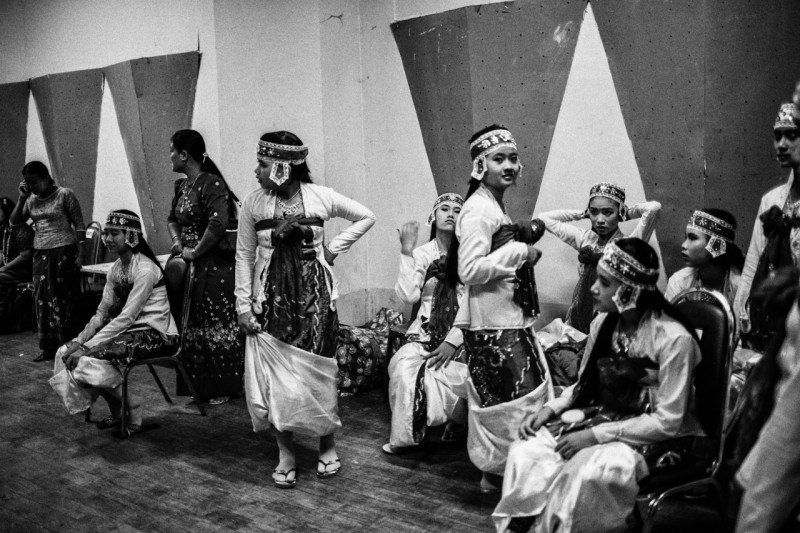One of my most vivid memories growing up as young child in Romania is watching loud, drunken bears dancing wildly around my grandparents’ living room. Electrifying, enchanting, and at times also quite scary, the annual “bear dance” was always one of the highlights of our holiday season, especially given the strict era of Communist rule.
Every year, in a handful of towns and villages along the Trotus Valley of Romania, troupes of “dancing bears” — men and women of all ages wearing real bear skins — tour villages and visit people’s homes between Christmas and the start of January. This traditional folk ritual, where raucous packs of bears dance and play music for tips, liquor, and cubes of pig fat, is believed to chase away bad spirits from the previous year.
A troupe of bears performs in central Comăneşti during its annual Bear Parade and competition. The mayor organizes the event and offers a cash prize to the best bear troupe. Comănești, Bacău, Romania
When I was only eight years old, my family left Romania behind, and we became political refugees in Yugoslavia. After initially resettling in Canada, we then moved to New York when I was 16. I later went on to study Economics, Neuroscience, and International Development, and eventually returned overseas when I took up a career in humanitarian aid, often working with displaced populations, much like my family and I once were.
In 2013, I decided quit aid work and fully pursue a career as a photographer. I continued to spend most of my time in areas experiencing social unrest or humanitarian emergencies, but now I had a camera in hand. Last year, however, I took a week to return to Romania and visit my ailing grandmother — and to see the dancing bears again.
A troupe of bears dance through Comăneşti, stopping at homes where they have been invited to perform. Comănești, Bacău, Romania
My mother’s childhood friends introduced me to Dumitru Toloaca and his troupe of men, women and children clad in bearskins. I spent a few freezing days photographing them as they performed in the main square of Comăneşti, and then danced their way into the night, through villages like Asău, on their way to private homes where they had been invited to perform.
It’s not unusual for roads to be blocked by bear troupes towards the end of the year.
Cătălin Apetroaie chats with a young bear and the ‘bear tamer’ seated on his porch. He and the rest of Toloacă’s troupe have just finished performing for Apetroaie’s family.
There were so many times that I wanted to put my camera down, put on a bearskin, and join them. It was magical, like going into a fairy tale.
At first, you can’t see much because it’s so dark. You just hear the crunch of the bear-claw boots on the snow and then, all of a sudden, drumbeats break out and you hear the sound of flutes echoing through the alleyways. Then the dancers pass under a streetlamp, and you see bears caught in a snowstorm!
Toloaca’s troupe of bears dance through the night, making their way to the homes where they’ve been invited to perform. Asău, Bacău, Romania
As a child I remember how beautiful it was to wake up filled with anticipation on a snowy December morning and to hear drumbeats and chanting echoing through the valley. The bear troupes would come door to door and everyone would let them in. They were quite rambunctious, swinging their heads around and causing a mess as the snow on them melted.
Catalin Apetroaie, a bear in Toalaca’s troupe, serves his fellow bears a refueling of pig fat at his home in Laloaia where they have just performed. His wife fills up glasses of homemade palinka liquor.
The origins of Romania’s bear dance date back to the 1930s when the Roma, or gypsies, would descend from the surrounding mountains with bear cubs on leashes, and visit the homes of villagers. My grandmother still recalls how gypsies would be given a tip in exchange for the bear cub walking on the backs of the villagers, said to alleviate back pain.
Once a bear aged, the Roma would then employ it for a different purpose when visiting households — they would set the bear to walk on hot metal sheets, which would cause the bear to “dance” or skitter about on the metal to avoid the burning sensation beneath its feet.
Between visits to houses where they have been invited to perform, Toloaca’s troupe of bears stops at a bar for some rest, drinks and more celebrating. Asău, Bacău, Romania
No one really knows when the Roma began wearing bear skins and imitating their dancing bears, or when ethnic Romanians then adapted the ritual, but the gypsy origins are still clearly discernible in the lyrics sang by the “bear tamer” as well as the more traditional costumes sometimes worn, often complete with black stove grease or soot smeared onto the tamer’s face, to imitate the darker skin of a gypsy.
A troupe of bears performs down the main street in Moinesti, during the town’s annual bear parade. Moinești, Bacău, Romania
Today, the Roma are largely excluded from the tradition of bear dancing. Reasons include widespread discrimination against the Roma, as well as the increased cost of bear skins — as bear hunting in Romania has been strictly regulated for some time now, one skin can fetch up to 2,000 Euros.
A lady bear in Toloaca’s troupe plays with the young son of Catalin Apetroaie, a bear dancer himself, after a performance at his home. The child’s grandmother scurries by while his great-grandmother peers at the bears from inside the house. Asău, Bacău, Romania
In today’s post-communist era, modernization and westernization have created a new generation of youth more interested in video games than folk traditions . Moreover, most young adults move to nearby countries or larger cities, in search of work, leaving the rural areas populated by only the elderly or very young. It’s difficult to find people that will carry on the tradition. Coupled with the increasing financial struggles of rural households — after the the fall of communism, rural areas became poorer while urban ones became wealthier — the bear dance tradition is now at risk of disappearing.
A troupe of bears from Asău village performs in central Comăneşti during the town’s annual Bear Parade and Competition.
Although in the minority, female bears can be found in nearly every troupe. Comănești, Bacău, Romania
So far, Romania’s bear dance has survived largely due to the efforts of local governments who throw parades and competitions to incentivize the organization of bear troupes, as well as to recognize and celebrate the individual efforts of dedicated and passionate troupe leaders like Dumitru Toloaca. Like most of the other troupe leaders in the area, Toloaca grew up with the tradition as a boy and holds it close to his heart.
Dumitru Toloaca embraces his daughter, Roxana, as his troupe dances to the beat of the drummers and the lyrics of his bear tamer. Roxana, an only child, is his only hope for his bear troupe to carry on into the next generation. Asău, Bacău, Romania
About a year ago, at the urging of concerned local governments, UNESCO initiated a process that may result in Romania’s bear dance being included on its official “List of Intangible Cultural Heritage in Need of Urgent Safeguarding,” an international measure for the protection of cultural practices that are in danger of disappearing. This process takes at least two years to complete, and acceptance is not guaranteed.
Toloaca’s bears dance and encircle their tamer, Gabriel Hanganu. After winning first place at Comanesti’s annual Bear Parade, Toloaca‘s troupe celebrated in the streets, singing, dancing and toasting with homemade palinka liquor handed out by residents. Asău, Bacău, Romania
THIS ARTICLE WAS ORIGINALLY PUBLISHED ON MAPTIA.
DIANA ZEYNEB ALHINDAWI
Diana is a photographer working internationally on stories about humanitarian, human rights, or cultural issues.





























































































































































































































